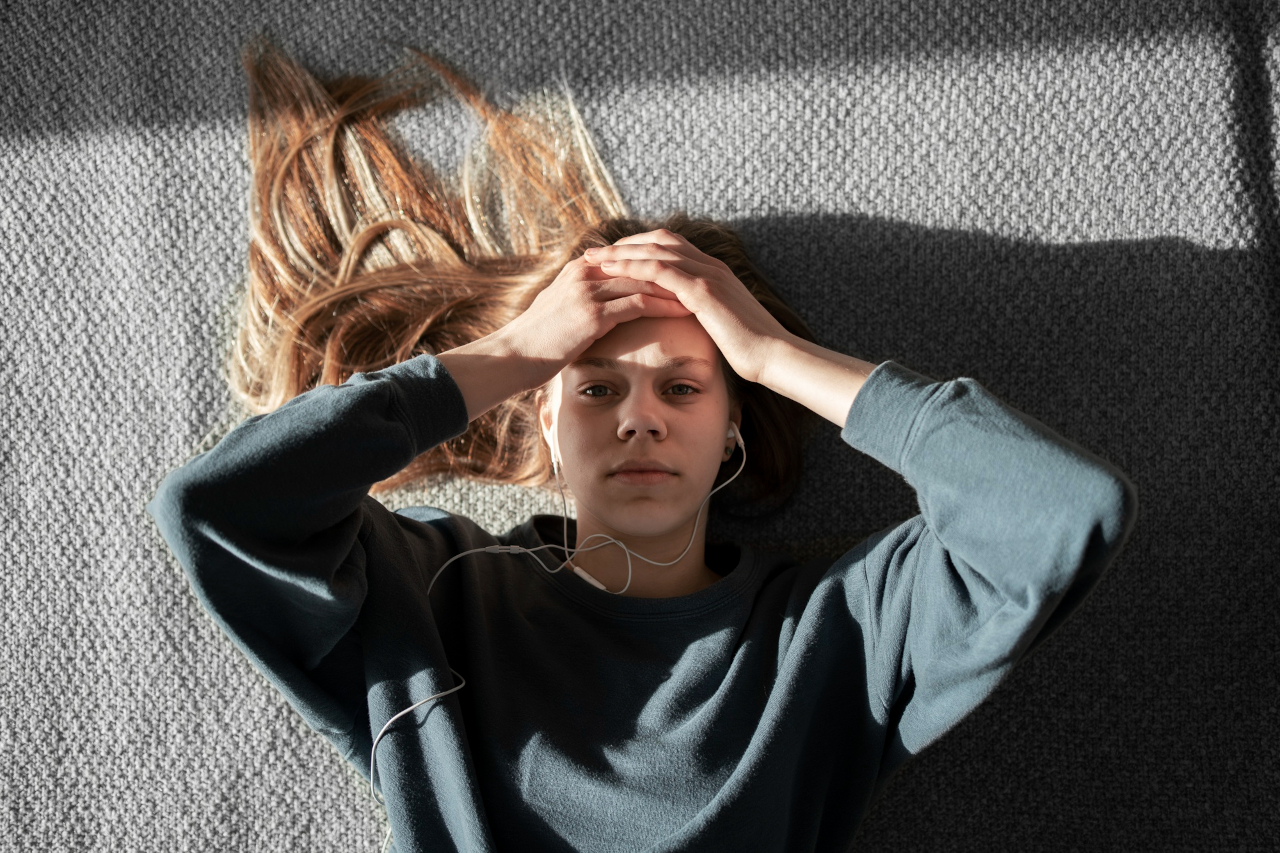
How Hypnotherapy Can Help Teens Experiencing Intrusive Self-Harm Thoughts
Here are some big questions to ask you as a parent:
Have you noticed your teen is a little more withdrawn lately? Has their mood shifted towards lower emotions? Have they been wearing long-sleeves when they normally don’t cover their arms?
Are they on their devices more than usual, or less than usual? Has your teen watched a specific film or TV show recently that touches sensitive topics and you find they may take it too to heart?
Lastly: are you worried your teen is experiencing intrusive self-harm thoughts, or has already self-harmed?
If you find out your teen has intrusive self-harming thoughts or is self-harming, it is 100% natural to experience a rollercoaster of emotions. No one wants to see their child harmed, especially by the child themselves.
In a 2023 B.C. Adolescent Health Survey about teens between 12-19, it was found that in comparison to previous years, they were more likely to self-harm, suffer from eating disorders, and experience abuse. 24% percent of these teens reported they self-harmed on purpose at some point within the year before they completed the survey, which is up from the 15% recorded 10 years ago.
It’s hard to understand what goes through the minds of our teens, and why they may be afraid to tell you what’s going on for them. The best thing you can do as a parent to gain insight into your teen’s thoughts, feelings, and behaviour is to stay calm, be respectful and reassuring, be non-judgmental, and actively listen. The most important thing is to let your teen know that having strong feelings is normal, but hard to have an experience, especially during this stage in their lives, things seem even harder.
When having these thoughts of self-harming, especially around that age, it can sometimes be hard to pin-point what triggered these thoughts, why they are occurring and what can we do about them.
Hypnotherapy has helped many in treating depression, anxiety, and other such mental health issues, by delving into the subconscious towards the root of it all. It is no different in helping teens through these intrusive self-harm thoughts.
Learn what self-harm is, the types of self-harm, how screen time (including social media and television) affects their mental health, signs to look for, and how hypnotherapy may be the right path for your teen in helping them heal from these thoughts.
First, we need to examine what exactly self-harm is and what you need to look for if you feel your teen is hurting themselves.
What is Self-Harm, and What are the Signs?
Self-harm is when someone hurts themselves on purpose as a coping mechanism or trauma response to deal with painful and/or strong emotions. It serves as a way to have control over these feelings or feel a sense of relief or release from them, as a way of trying to heal, as twisted as that may seem.
When someone is in deep distress, a clear sign can be self-harm. It is different than suicide, though self-harm severity can lead towards it. In most cases, the intention with self-harm is emotional relief rather than death.
There are different ways of self-harm, some more obvious and serious than others.* Teens that are self-harming may:
- Cut, scratch, carve, brand, or mark themselves.
- Pick at their scabs continuously so they don’t heal.
- Pull their own hair.
- Burn or graze themselves.
- Bite, bruise, or hit themselves.
- Use hard surfaces to hit parts of their bodies.
*Please keep in mind that some of these listed behaviours can also be linked to obsessive-compulsive disorder (OCD), anxiety, and other mental health conditions, and don’t necessarily mean your teen is self-harming. By having a gentle conversation with your teen about these behaviours, you can differentiate whether it is self-harming or potentially something else.
Self-cyberbullying or digital self-harm is when teens create alternative online personas for themselves on social media and post hurtful, cruel comments about themselves on their real accounts. These alternative identities may also receive cruel comments from other people.
Some teens deal with their strong emotions in serious but less obvious ways, which can include binge-drinking, and other substance use, having unsafe sex, or eating disorders.
If you are concerned your teen has intrusive self-harming thoughts, or have been self-harming, here are signs to watch for.
Behavioural Signs:
- Avoiding activities such as swimming, where their legs, arms, or upper body is seen, or wearing clothing that covers their arms and legs.
- Hiding objects such as razor blades, stencil knives, lighters, and matches.
- Appearing to use Band-Aids and antiseptic more often.
- Noticeable changes in their eating and sleeping habits and patterns.
- Appearing to have lost interest in activities they usually enjoy or stop hanging out with their friends.
- Skipping school or having a drop in school performance.
Emotional Signs:
- Substantial change in their mood.
- Frequently irritable.
- Ongoing temper outbursts.
- Feeling sad, empty, or hopeless more often.
- Feeling worthless or guilty more often.
- Their appearance changes, usually from lack of self-care.
Physical Signs:
- New injuries they either can’t or won’t explain.
- Visible agitation in regards to their long sleeves, or physical body.
- Slow, sluggish reactions, feeling extra tired and drained of energy.
Teens that self-harm often try hiding it, due to being ashamed of their behaviour and worry that they will be rejected by others because of it, that people will be angry with them for self-harming.
Reasons Teens May Self-Harm
There can be many reasons for why a teen chooses to hurt themselves. A common reason is to manage their emotions. When emotions are hard to deal with or express, self-harm is sought out and provides temporary relief.
Another reason for self-harming can be the need to be in control. When someone feels a disconnect from their body, self-harm can give the feeling of “normal.”
A lot of teens may experience bullying, whether on social media or offline, or have a traumatic experience and not know how to process the feelings that come with it or how to ask for help. They may start having thoughts of self-harming because that is a way they are able to control a feeling and bodily sensation—as a coping mechanism. Usually, by the time these thoughts arise, the self-harm is already occurring, or they are close to acting on it in some form.
Self-harm, however, is not a mental health disorder, though it is associated with common mental health problems such as substance abuse, depression, anxiety, or eating disorders, for example. Individuals who self-harm are at greater risk for mental disorders.
Another common reason is social media. Is your teen’s self-harm behaviour influenced by their online habits?
What is Social Media’s Influence on Teens’ Mental Health?
We know that screen addiction has been a rising issue since the arrival of the smartphone, as the patterns arise of new gadgets every needs to have, the latest social media platform and the popularity complex along with the never-ending complexities of body image and self-esteem.
Many of us adults never had to go through this issue as a teen or caught the tail end of the transition from no technology to all the technology being thrown in our faces.
Being able to navigate the world of screens as a teenager may not seem as easy as it looks. Teens walking mindlessly scrolling their phone to check out the latest Tik-Tok video on some new trend, which may or may not be seriously toxic, especially to teens.
As parents, it can be hard to watch your child go through these harmful behaviours, especially if you grew up without screens and social media, not being able to fully understand the impact social media and screen time really has.
Potential downsides of teens using social media
An article by the CBC presents the professors, doctors, and neuroscientists specializing in studying the effect social media use has on young people in Canada.
- The Canada Research Chair in neuroscience and learning disorders at Western University is held by Emma Duerden. She uses brain imaging to study the effects of social media use on children’s brains.
- Dr. Rachel Mitchell, child and youth psychiatrist at Sunnybrook Health Sciences Centre in Toronto, treats and studies how social media use affects mental health.
- The Canada Research Chair in preventive mental health at Sainte-Justine Hospital in Montreal, Quebec, is held by psychiatry professor Patricia Conrod.
In particular, Conrod is concerned with the defaults on devices that are used for social media are set for adults, which tend to be an essential part of the lives of most young people. The features that keep youth scrolling their social media feeds also creates a loss of self-control and time.
“Just because something makes you feel good doesn’t mean it’s good for you,” said Conrod.
She encourages children and teens to pay attention when viewing content as to how their mood changes.
Using social media for extended periods of time throughout the day gives greater risk for unpleasant mental health outcomes, such as depression and anxiety symptoms. Other issues that may arise are cyberbullying-related depression, body image and disordered eating behaviours, and poor sleep quality connected to social media use.
The algorithms of social media are built to promote your interests. They’re designed to track you when you look at sites like Amazon for certain products. They then show you ads for related products on other purchasing sites as well as on Amazon. Or if you like a specific music artist and follow their official page, it will then show you fan pages, groups, and merchandise (official and unofficial).
The bigger problem is when a teen does a search for any type of mental health condition, such as depression, self-harm, or suicide. This algorithm will feed information to them about these things, and the teen then may think and assume everyone around them is depressed or thinking about self-harm, or suicide, which isn’t necessarily good for mental health.
When does content become an issue for teens?
Unless properly regulated, or reported when seen showing on a teen’s feed, extreme, inappropriate, and harmful content can be easily accessible by teens.
According to recent research, in the most extreme of cases, deaths have been connected to suicide-and self-harm related content, like “cutting,” partial asphyxiation, and risk-taking social media challenges. Studies also have found that showing or talking about this kind of content can normalize these types of behaviours.
The latest research also states that people who target youth—for example, adults who seek to sexually exploit teens or extort them financially through threat or actual distribution of intimate images—may use social media for these predatory behaviours.
In Canada, we have Bill C-63: Online Harms Act, which was introduced in the House of Commons February 26 2024. Despite the overreach with this bill that allows overall censorship and can silence voices of dissent. It establishes Canada’s first federal online content moderation system. This specifically focuses on seven categories of content harmful to children/teens:
- Content sexually victimizes a child or re-victimizes a survivor.
- Intimate content shared without consent.
- Hate related content.
- Content pushing violent extremism or terrorism.
- Content pushing violence.
- Content that is used to bully children and teens.
- Content that encourages a child/teen to harm themselves.
To sum up: social media has a huge influence on how teens interact with others and how they see themselves reflected and present themselves online and offline. Not to mention the screen addiction that comes with doom scrolling and needing to always be in the loop.
Now, we currently have regulations in place for social media for harmful content…what about film and television? How can we protect our teens from watching this kind of content? Or should we?
Depiction of Self-Harm and Other Mental Health Issues in Film and Television that Teens Watch
Film and television have never been squeaky clean in terms of harmful content for children and teens.
When the Netflix show “13 Reasons Why” was released, it created a huge uproar about its massive self-harm and suicide content. Many believed it glamourized the issues that were portrayed in the series; that teens would get the idea to self-harm if they saw it on television.
When it comes to the portrayal of these themes in fictional content, the line of ethics becomes blurred since censoring fiction can do more harm than good, however producers of these shows have a responsibility to evaluate any potential impact that this kind of content has on those vulnerable, and to support their viewers as well as parents, educators, and mental health practitioners through prevention campaigns.
UCLA’s Center for Scholars and Storytellers published a report conducting research which examined “13 Reasons Why” for its depictions of suicide, sexual assault, domestic violence, bullying, homelessness, and school shootings.
68 of 157 children between 13 and 17 years of age that participated in the study had watched Season 3 of the Netflix series. Each participant completed a survey at the beginning of the study about mental health, depression, bullying, and related topics. At the end of the study, they completed another survey asking, among other questions, if they went searching for information about these issues.
The group that watched the show answered questions pertaining to whether, and with whom, they discussed the show and whether what they saw led them to seek out further information on the topics that were raised.
62 of the 68 who watched the show reported searching for information on mental health related issues related to what they saw. Many of them reported discussing those issues with others—especially mental health, bullying, and suicide.
It was found that many of the teens that watched TV shows that portray these self-harm and mental health issues talk about it with their peers, parents, and partners. Challenging and realistic stories inspired these youth to speak up about them and they wanted to learn more about mental health.
While shows like “13 Reasons Why” are problematic for portraying self-harm behaviour, they have a chance to encourage meaningful discussion around these issues. So if you feel that something your teen has watched may be influencing their self-harm behaviour, take some time to have a safe, calm conversation with them about the media they are taking in.
Ask what they find fascinating about this content. What do they think is influencing them and their decisions?
At the end of the day, if you feel your teen is having trouble with any kind of self-harm behaviour and you’re not sure what the root cause may be, hypnotherapy may be right for them.
How Can Hypnotherapy Help My Teen with Intrusive Self-Harm Thoughts?
Hypnotherapy can guide the mind into a state of deep focus and relaxation. It can help to identify the root cause of your teen’s self-harm, or help with an underlying mental health condition. Hypnotherapy helps with behavioural change in the subconscious from unhelpful intrusive thoughts to more self-confidence and how to manage the urge to self-harm.
90% of the decisions and actions we make in our lives are subconscious, especially our habits, which are almost rooted in our mind subconsciously. Behavioural change through our subconscious is necessary, as it can be difficult to change our actions, thoughts, or decisions otherwise.
Since hypnotherapy works directly with the subconscious to change behaviour, the effects for stopping intrusive self-harm thoughts and behaviours can be profound.
Keep in mind, stopping the self-harm thoughts and behaviour without resolving the cause of the issue means the effects of hypnosis will not last long. Identifying and resolving the root cause for the intrusive self-harm thoughts or behaviour may require multiple hypnotherapy sessions in order to see lasting results from treatment.
The root cause can be emotional trauma that has been suppressed subconsciously. Mental health issues like anxiety, depression, or substance abuse, for example, can be found to be the root cause, and can also be resolved with hypnotherapy.
Regardless of what your teen’s situation is, I can provide healing and relief through hypnotherapy, if you and your teen feel it is the right path for them.
Emergency Resources
I’m including this section because in the event your teen mentions to you of wanting to harm themselves, please always take them seriously. This includes mentioning self-harm, dying, or any attempts at ending their life.
Act right away on these comments from your teen. Call their primary healthcare provider. You can also use these services 24/7:
- Suicide crisis: 1 800 SUICIDE (1-800-784-2433)
- Mental health issues: 310-6789 (24 hours) (no area code needed)
- KUU-US Aboriginal crisis line: 1-800-588-8717 (24 hours)
- Medical emergency: 911
You can also use these online resources:
- Crisis Centre
- KUU-US Crisis Line Society
- Kids Help Phone (Text CONNECT to 686868)
- Youth In BC Chat
- HealthLink BC: Warning Signs of Suicide in Children & Teens
Is Hypnotherapy Right for Your Teen?
If you have any questions about my article and you want to know more about how I can help your teen with intrusive self-harm thoughts and behaviours, you can book a free 20-minute consultation with me, with no obligation. This allows me to better understand your teen’s needs so I can customize an individual hypnotherapy plan to help them.
If you’re curious or have questions about your teen trying hypnotherapy, you can check out my previous articles here: Why Teens Should Consider Hypnotherapy, and Benefits of Hypnotherapy for Teens.
Finally, if you have any questions or concerns about intrusive self-harm thoughts in teens, about hypnotherapy in general, or about booking a session, contact me today.
Creative Commons Attribution: Permission is granted to repost this article in its entirety with credit to Healing Soul Hypnosis and a clickable link back to this page.










